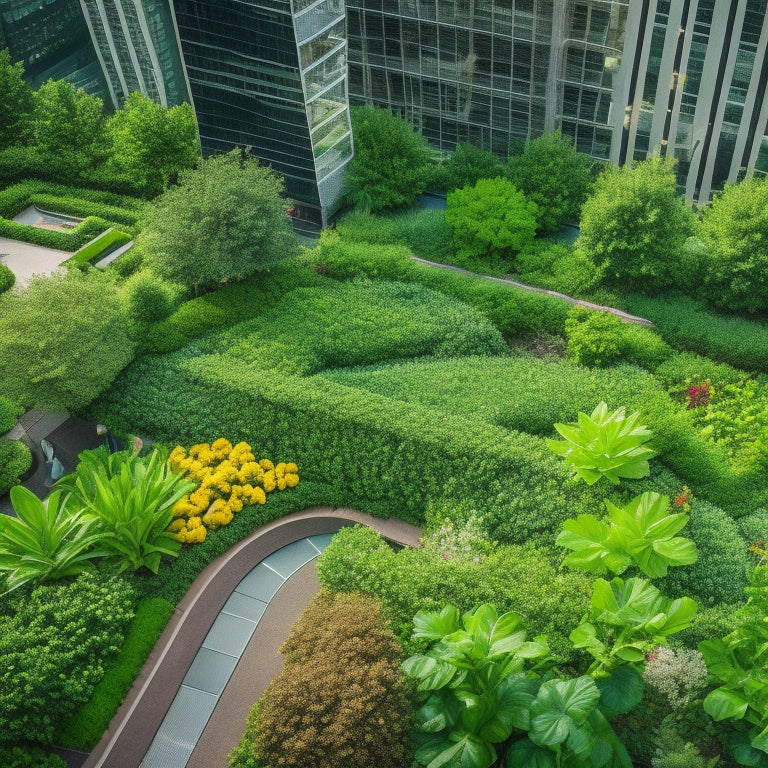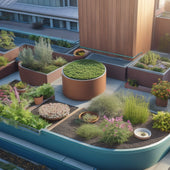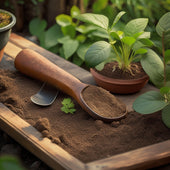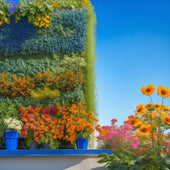
5 Green Roof Tips for Stormwater Management Success
Share
To create a highly effective green roof for stormwater management, you'll want to start by selecting durable, eco-friendly materials that meet local building codes. Next, design your roof to maximize water retention capacity by incorporating permeable membranes and choosing soil with high organic matter content. Select plants with deep roots that can absorb and filter stormwater effectively. Install a leak-proof membrane layer using high-quality materials and proper waterproofing techniques. Finally, establish a regular maintenance routine to inspect components, monitor water flow, and control weed growth. By following these tips, you'll be well on your way to ideal stormwater management - and there's more to explore.
Key Takeaways
• Opt for eco-friendly, locally sourced, and recycled materials that meet local building codes and regulations to ensure a sustainable green roof.
• Design the green roof with a focus on water retention capacity, incorporating permeable membranes, and selecting soil and vegetation that thrive in local climate conditions.
• Choose a diverse range of plants with deep roots, such as succulents, grasses, and shrubs, that can absorb and filter stormwater effectively.
• Install a high-quality, leak-proof membrane layer, following proper waterproofing techniques and inspecting for defects or damage.
• Establish a regular maintenance routine, inspecting the roof's components, monitoring water flow, and controlling weed growth to ensure optimal performance.
Selecting the Right Roofing Materials
When designing a green roof for stormwater management, you'll want to choose roofing materials that not only support vegetation but also withstand harsh weather conditions, facilitate drainage, and meet local building codes and regulations. Material durability is vital, as it directly impacts the roof's lifespan and maintenance needs. Look for materials with high resistance to weathering, such as waterproofing membranes and durable growing media.
Cost-effectiveness is also important, as it can significantly impact your project's budget. Consider locally sourced materials or recycled options to reduce costs without compromising performance.
In addition to functional requirements, don't overlook the importance of eco-friendly options and aesthetic appeal. Choose materials that are sustainable, non-toxic, and produced locally to minimize environmental footprint. Furthermore, select materials that complement your building's architecture and surrounding landscape. This won't only enhance the roof's visual appeal but also create a harmonious integration with the environment.
Designing for Water Retention Capacity
By optimizing your green roof's water holding capacity, you can reduce stormwater runoff and create a more resilient and sustainable urban ecosystem. This is crucial in urban areas where impervious surfaces can worsen stormwater management issues.
To achieve this, you'll need to focus on designing a green roof that can effectively retain and manage rainfall.
Consider incorporating drainage solutions, such as permeable membranes or built-in water storage systems, to slow down stormwater runoff and allow for gradual infiltration into the soil.
Select a soil composition that's optimized for water retention, such as a mix with high organic matter content and good structure. This will help to increase the soil's water-holding capacity and reduce runoff.
Choose vegetation that's adapted to the local climate and can thrive in a water-holding environment. This will ensure that your green roof remains healthy and functional, even during heavy rainfall events.
Plant Selection for Stormwater Absorption
You'll want to select plants that aren't only aesthetically pleasing but also capable of absorbing and filtering stormwater, and some of the most effective options include succulents, grasses, and shrubs with deep roots. These plants have adapted to thrive in environments with varying water levels, making them ideal for stormwater management.
When choosing plants, consider the soil composition of your green roof. For instance, succulents excel in well-draining soils, while grasses and shrubs prefer soils with higher organic matter content. Plant diversity is also essential, as it increases the roof's ability to absorb and filter stormwater. Aim for a mix of plants with different growth habits, leaf structures, and root depths to maximize water uptake.
Installing a Leak-Proof Membrane Layer
A pivotal step in green roof construction is installing a leak-proof membrane layer. This layer prevents water infiltration into the building and safeguards the integrity of the entire system. When you're installing the membrane layer, you'll want to make sure you're using the right materials and techniques to secure a watertight seal.
Here are some key considerations to keep in mind:
-
Choose a high-quality membrane material: Look for materials that are specifically designed for green roof applications and can endure the weight and moisture of the vegetation.
-
Follow proper waterproofing techniques: Guarantee that the membrane is properly sealed around penetrations, such as vents and drains, and that all seams are securely bonded.
-
Conduct thorough quality control: Inspect the membrane layer for any defects or damage before moving on to the next stage of construction.
Regular Maintenance for Optimal Performance
To ensure your green roof continues to effectively manage stormwater and thrive over time, regular maintenance is essential. Establishing a routine that includes inspecting the roof's components, monitoring water flow, and performing necessary repairs is important.
You'll want to schedule regular drainage inspections to guarantee the system is functioning properly and make adjustments as needed. Weed control is also vital, as invasive species can compromise the roof's integrity and hinder its ability to manage stormwater. Regularly inspect the roof for signs of weed growth and take action to prevent their spread.
Additionally, maintain your irrigation system to ensure it's providing the right amount of water to your plants. Perform regular soil assessments to identify any nutrient deficiencies or pH imbalances that may be affecting plant health.
Frequently Asked Questions
Can a Green Roof Be Installed on an Existing Building?
You can retrofit an existing building with a green roof, but be prepared to overcome retrofit challenges like structural integrity assessments and installation process modifications to guarantee a successful, stress-free transformation.
How Do I Ensure Structural Integrity With Added Green Roof Weight?
'Measure twice, cut once' - ensuring structural integrity with added green roof weight is essential. You'll need to assess load bearing capacity, consider structural reinforcement, and select suitable drainage solutions, all while factoring in engineering considerations to avoid costly mistakes.
Are Green Roofs Suitable for Buildings in High-Wind Areas?
You'll need to guarantee wind resistance through secure installation and regular maintenance to reap the benefits of a green roof in high-wind areas; proper design and attachment systems can help mitigate wind uplift and secure a successful installation.
Can a Green Roof Be Used as a Recreational Space?
As you envision a rooftop oasis, you're not just chasing a mythic Eden; you're accessing green roof benefits. A well-designed space can become a recreational haven, where you can indulge in leisure activities, free from the urban jungle's constraints.
Do Green Roofs Attract Pests or Create Noise Issues?
You'll want to take into account pest prevention measures, like using pest-resistant plants and maintaining a clean roof, in order to avoid unwanted critters. Additionally, you can implement noise control strategies, such as sound-absorbing materials, to reduce disruptions.
Related Posts
-

3 Best Roof Garden Drainage Solutions for Planters
When designing your roof garden, you'll want to implement a planter drainage system that guarantees water flows freel...
-

3 Best Roof Garden Drainage Solutions for Planters
When designing your roof garden, you'll want to implement a planter drainage system that guarantees water flows freel...
-

3 Best Roof Garden Drainage Solutions for Planters
When designing your roof garden, you'll want to implement a planter drainage system that guarantees water flows freel...
-

3 Best Roof Garden Drainage Solutions for Planters
When designing your roof garden, you'll want to implement a planter drainage system that guarantees water flows freel...
-

3 Best Roof Garden Drainage Solutions for Planters
When designing your roof garden, you'll want to implement a planter drainage system that guarantees water flows freel...
-

3 Best Roof Garden Drainage Solutions for Planters
When designing your roof garden, you'll want to implement a planter drainage system that guarantees water flows freel...
-

3 Best Roof Garden Drainage Solutions for Planters
When designing your roof garden, you'll want to implement a planter drainage system that guarantees water flows freel...
-

3 Best Roof Garden Drainage Solutions for Planters
When designing your roof garden, you'll want to implement a planter drainage system that guarantees water flows freel...
-

3 Best Roof Garden Drainage Solutions for Planters
When designing your roof garden, you'll want to implement a planter drainage system that guarantees water flows freel...
-

3 Best Roof Garden Drainage Solutions for Planters
When designing your roof garden, you'll want to implement a planter drainage system that guarantees water flows freel...
-

3 Best Roof Garden Drainage Solutions for Planters
When designing your roof garden, you'll want to implement a planter drainage system that guarantees water flows freel...
-

3 Best Roof Garden Drainage Solutions for Planters
When designing your roof garden, you'll want to implement a planter drainage system that guarantees water flows freel...
-

3 Best Roof Garden Drainage Solutions for Planters
When designing your roof garden, you'll want to implement a planter drainage system that guarantees water flows freel...
-

What Makes a Good Used Trowel for Planters
When searching for a good used trowel for planters, you'll want to prioritize corrosion-resistant materials like stai...
-

What Makes a Good Used Trowel for Planters
When searching for a good used trowel for planters, you'll want to prioritize corrosion-resistant materials like stai...
-

What Makes a Good Used Trowel for Planters
When searching for a good used trowel for planters, you'll want to prioritize corrosion-resistant materials like stai...
-

What Makes a Good Used Trowel for Planters
When searching for a good used trowel for planters, you'll want to prioritize corrosion-resistant materials like stai...
-

What Makes a Good Used Trowel for Planters
When searching for a good used trowel for planters, you'll want to prioritize corrosion-resistant materials like stai...
-

What Makes a Good Used Trowel for Planters
When searching for a good used trowel for planters, you'll want to prioritize corrosion-resistant materials like stai...
-

What Makes a Good Used Trowel for Planters
When searching for a good used trowel for planters, you'll want to prioritize corrosion-resistant materials like stai...
-

What Makes a Good Used Trowel for Planters
When searching for a good used trowel for planters, you'll want to prioritize corrosion-resistant materials like stai...
-

What Makes a Good Used Trowel for Planters
When searching for a good used trowel for planters, you'll want to prioritize corrosion-resistant materials like stai...
-

What Makes a Good Used Trowel for Planters
When searching for a good used trowel for planters, you'll want to prioritize corrosion-resistant materials like stai...
-

What Makes a Good Used Trowel for Planters
When searching for a good used trowel for planters, you'll want to prioritize corrosion-resistant materials like stai...
-

What Makes a Good Used Trowel for Planters
When searching for a good used trowel for planters, you'll want to prioritize corrosion-resistant materials like stai...
-

What Makes a Good Used Trowel for Planters
When searching for a good used trowel for planters, you'll want to prioritize corrosion-resistant materials like stai...
-

What Makes a Good Used Trowel for Planters
When searching for a good used trowel for planters, you'll want to prioritize corrosion-resistant materials like stai...
-

What Makes a Good Used Trowel for Planters
When searching for a good used trowel for planters, you'll want to prioritize corrosion-resistant materials like stai...
-

What Makes a Good Used Trowel for Planters
When searching for a good used trowel for planters, you'll want to prioritize corrosion-resistant materials like stai...
-

What Makes a Good Used Trowel for Planters
When searching for a good used trowel for planters, you'll want to prioritize corrosion-resistant materials like stai...
-

What Makes a Good Used Trowel for Planters
When searching for a good used trowel for planters, you'll want to prioritize corrosion-resistant materials like stai...
-

What Makes a Good Used Trowel for Planters
When searching for a good used trowel for planters, you'll want to prioritize corrosion-resistant materials like stai...
-

What Makes a Good Used Trowel for Planters
When searching for a good used trowel for planters, you'll want to prioritize corrosion-resistant materials like stai...
-

What Makes a Good Used Trowel for Planters
When searching for a good used trowel for planters, you'll want to prioritize corrosion-resistant materials like stai...
-

What Makes a Good Used Trowel for Planters
When searching for a good used trowel for planters, you'll want to prioritize corrosion-resistant materials like stai...
-

What Makes a Good Used Trowel for Planters
When searching for a good used trowel for planters, you'll want to prioritize corrosion-resistant materials like stai...
-

What Makes a Good Used Trowel for Planters
When searching for a good used trowel for planters, you'll want to prioritize corrosion-resistant materials like stai...
-

5 Tips for Thriving Vertical Vegetable Gardens
To thrive in vertical vegetable gardening, you'll want to choose a planter that meets the unique needs of your veggie...
-

5 Tips for Thriving Vertical Vegetable Gardens
To thrive in vertical vegetable gardening, you'll want to choose a planter that meets the unique needs of your veggie...
-

5 Tips for Thriving Vertical Vegetable Gardens
To thrive in vertical vegetable gardening, you'll want to choose a planter that meets the unique needs of your veggie...
-

5 Tips for Thriving Vertical Vegetable Gardens
To thrive in vertical vegetable gardening, you'll want to choose a planter that meets the unique needs of your veggie...
-

5 Tips for Thriving Vertical Vegetable Gardens
To thrive in vertical vegetable gardening, you'll want to choose a planter that meets the unique needs of your veggie...
-

5 Tips for Thriving Vertical Vegetable Gardens
To thrive in vertical vegetable gardening, you'll want to choose a planter that meets the unique needs of your veggie...
-

5 Tips for Thriving Vertical Vegetable Gardens
To thrive in vertical vegetable gardening, you'll want to choose a planter that meets the unique needs of your veggie...
-

5 Tips for Thriving Vertical Vegetable Gardens
To thrive in vertical vegetable gardening, you'll want to choose a planter that meets the unique needs of your veggie...
-

5 Tips for Thriving Vertical Vegetable Gardens
To thrive in vertical vegetable gardening, you'll want to choose a planter that meets the unique needs of your veggie...
-

5 Tips for Thriving Vertical Vegetable Gardens
To thrive in vertical vegetable gardening, you'll want to choose a planter that meets the unique needs of your veggie...
-

5 Tips for Thriving Vertical Vegetable Gardens
To thrive in vertical vegetable gardening, you'll want to choose a planter that meets the unique needs of your veggie...
-

5 Tips for Thriving Vertical Vegetable Gardens
To thrive in vertical vegetable gardening, you'll want to choose a planter that meets the unique needs of your veggie...
-

5 Tips for Thriving Vertical Vegetable Gardens
To thrive in vertical vegetable gardening, you'll want to choose a planter that meets the unique needs of your veggie...
-

5 Tips for Thriving Vertical Vegetable Gardens
To thrive in vertical vegetable gardening, you'll want to choose a planter that meets the unique needs of your veggie...
-

5 Tips for Thriving Vertical Vegetable Gardens
To thrive in vertical vegetable gardening, you'll want to choose a planter that meets the unique needs of your veggie...
-

5 Tips for Thriving Vertical Vegetable Gardens
To thrive in vertical vegetable gardening, you'll want to choose a planter that meets the unique needs of your veggie...
-

5 Tips for Thriving Vertical Vegetable Gardens
To thrive in vertical vegetable gardening, you'll want to choose a planter that meets the unique needs of your veggie...


